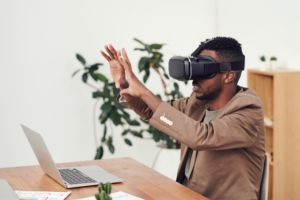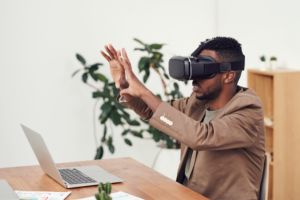As the sophistication of the software becomes more advanced, universities, companies, and even individuals are utilizing the beneficial tools of virtual reality to accelerate the learning process.
The future utilization of VR technology directs itself towards improving the quality of education available today.
How will VR technology improve the quality of education?
This technology manifests itself through a democratized learning format, an emphasis on exploration, and an all-inclusive community atmosphere.

The following top three factors aim to improve and reform the learning process our education system has adapted for the last hundred years.
- Democratized learning in VR
Although these two words are typically not linked together, the meaning of this phrase stresses the importance of accessibility and convenience in learning.
Students are typically restricted to the teachers and resources available in their area, the barrier of the location being their biggest challenge. They have succumbed to mediocre learning based on the educators present in the school district’s local neighborhoods.
Although these teachers might have good intentions, students’ knowledge is limited to the experience and quality of these teachers instead of being exposed to instructors who are well-known experts in a particular area.
Virtual reality can fix this problem.
The headset breaks all physical boundaries and allows students and teachers from across the world to interact and have an almost human experience.



Anyone with a headset can access the highest quality teachers, no matter their location or budget.
This virtual interaction cuts away any traveling expenses students might need to meet an expert, as they have immediate access to courses or material provided by these experts.
Students’ residence confines into a specific school district, their opportunities to become highly versed in a subject are minimal.
Imagine setting students up with a VR course taught by world-famous, Ivy League-level teachers, expanding their proficiency on a topic and exposing them to new future career opportunities.
Inventor of the World Wide Web, Sir Tim Berners-Lee, declares that the internet is an “open and democratic platform for all, allowing people to be informed, able to communicate, [and] being able to hold each other accountable.”
VR can live out this declaration by informing students with the best information available using the best instructors available, only to be accessed in a virtual platform.
- VR allows students to focus on exploration
Virtual reality technology also provides students with the ability to explore the world.



Anyone with a headset can go into a virtual world and experience new cultures they would not have had the means to be exposed to otherwise.
VR eliminates limitations based on location and budget, providing students the opportunity to travel the world like never before.
Students studying geography will be able to travel across Europe and Asia virtually. History classes about Greek and Roman culture can be taught in Greece or Rome, allowing the students to experience the culture they are studying.
Trying to learn Spanish? Why not take a trip to Spain?! This alternative to traveling is not only cost-effective but available to any student with access to a headset.
Field trips will be revolutionized. Students will experience the world on a whole new level, providing them with unique travel opportunities.
Statistics confirm that students remember 90% of the material when taught through experience, with the VR experience increasing the retention of academic knowledge and overall benefiting the learning process.
- Virtual Reality enables inclusivity
The virtual experience cultivates a community aspect, ridding students of the fear of isolation through remote learning. E-learning, such as zoom, is convenient but can cause students to feel isolated from their peers.
Virtual reality creates an interactive atmosphere and a virtual world, encouraging students to interact with their environment.



Students can be in breakout rooms where they can physically interact with their classmates.
We are allowing for a more diverse learning experience, arguing that technology creates a more human experience.
This inclusivity also includes diversity among languages. Students can learn in their native language without the added barrier.
SignAloud gloves allow students to communicate in sign language and translate it into human speech. In alliance with VR, these gloves can be utilized on the platform for students to sign to their instructor and translate it into their native language. These gloves are the first step toward a more inclusive environment in the VR world, embracing a typically excluded group such as the deaf community.
In conclusion,
VR has provided several benefits to education, including:
- Democratized learning to create accessibility for all
- Limitless means of exploration
- An inclusive design, invoking a connected human interaction virtually
Virtual reality has all of the benefits of being in a physical classroom (in-person connection, emotional connectivity, and immersive atmosphere) mixed with the availability, convenience, and online freedom learning provides while also focusing on making strong community relationships.
*Written by Zuzu Pasch*